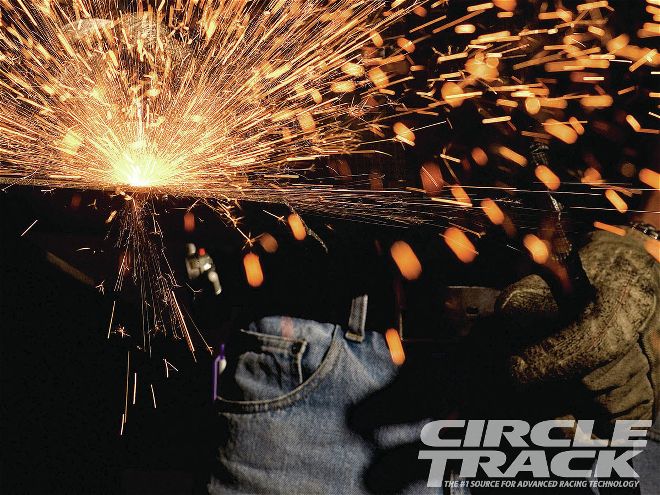
Steel is the bedrock of any race car. It's rolled into tubes, pressed into sheets and cut into every shape imaginable to create a race car chassis and the components that are bolted to it. And aluminum isn't far behind. When it comes to stock car chassis construction--and let's not forget about repair, either--we're not talking about mass production. Almost everything on the chassis is fabricated and welded together by hand and built to order.
But have you stopped to consider the quality of the raw materials your chassis is constructed from? Is the steel the proper alloy? Is the wall thickness of the tubing correct? Is it consistent from bumper to bumper, or even from one chassis to the next? If you aren't vigilant, who's to say your materials supplier is?
To find out more we contacted Al Lowe of AED Motorsport Products in Indianapolis, Indiana. AED is one of the only major materials suppliers for steel and aluminum tubing and sheetmetal (along with a lot of other stuff) that specializes exclusively in racing. It covers everything from Top Fuel drag racers, to Dirt Late Models, to Midgets, but AED doesn't do anything that isn't involved with going fast. We asked the company what chassis builders and racers should know about the companies they are purchasing their raw materials from. It came back with the following 10 questions--then we asked the questions ourselves. So the next time you need to purchase tubing, lead weight, sheetmetal for body panels, rod ends, or even Lexan for your windshield, ask your vendor these questions and see how they stack up.
1. Does it matter which mills and how many a metals vendor purchases from?
Yes is does. There are a number of different mills that produce materials for a number of different applications. One example I know of affects a large number of racers. All these guys that run Late Models and Modifieds, those types of cars that race a welded frame made from mild steel tubing, and that's what they are looking for. The racing industry may seem big to us, but for these steel mills we're a smaller player. There are mills that produce the materials that chassis builders are looking for, but they are looking at different industries, or stronger distribution facilities. It's things like general fabrication, general consumer products, and whatnot.
The same size material, or the same description of material, is also produced for the furniture industry and the fencing industry where the integrity of the material--it could be the consistency of the weld, it could be the quality of the material, it could be the consistency of the shape--isn't held to the same quality standard. But for those industries, furniture and fencing, they don't care. They are buying a cost-effective product versus a product based on quality. So for AED, we buy from mills or distributors that produce the better of the best. We only want to provide the cream of the crop, and by working with the mills that produce for the more demanding markets, we are able to do that economically.
Also, every mill produces to their own characteristic. They all have their own strengths and weaknesses when it comes to the materials they produce. So the more consistent you can be with your supplier, the happier the fabricators are going to be in-house.
It also will affect the nature of the car. You might talk to one guy who bought two cars from the same chassis builders that are supposed to be identical cars. But he'll tell you they don't perform the same. And quite honestly, it's probably due to differences in the manufactured materials, and that's a part of where it came from.
2. You carry the right size tubing I'm looking for, but is it the correct grade?
All materials, everything that our country produces for commercial manufacturing has a tolerance for different characteristics. It can be a mechanical tolerance as far as its strength, there is a chemical tolerance as far as what the chemistry is allowed to be, and there is a dimensional tolerance. The lower the grade of material--whether we are talking about a piece of steel or a piece of aluminum--the greater the allowable deviation in those tolerances.
We gauge allowances according to the AMS or ASTM specifications. Those are general metals industry guidelines regarding how specific products are to be produced. So a mild steel welded tube, which is at the low end, may have a mechanical deviation that's 30 percent from the high to the low. As we improve our grade of material, the tolerances become more constrictive, so the DOM might be a deviation of 25 percent from top to bottom range. And at the top of the range the deviation might be held to 15 to 20 percent. What we are seeing today from the metals industry, no matter if we are purchasing aluminum sheet, steel tubing, or something else, most mills have a sweet spot of what they typically produce. So we try to pick materials from the mills that are best at producing that particular piece of tubing, or sheet, or what-have-you.
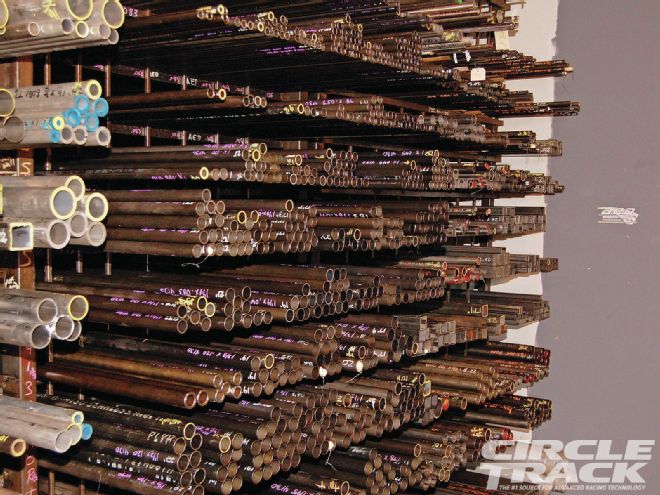 Steel mills vary the sizes and quality of tubing they produce depending on market forces. And unfortunately, racing doesn’t hold much sway compared to the larger industries out there. So builders have to be careful to make sure when designing a chassis that tubing they choose not only meets the rules but also won’t be phased out of production any time soon.
Steel mills vary the sizes and quality of tubing they produce depending on market forces. And unfortunately, racing doesn’t hold much sway compared to the larger industries out there. So builders have to be careful to make sure when designing a chassis that tubing they choose not only meets the rules but also won’t be phased out of production any time soon.
Take, for example, 1.5-inch tubing with 0.095-inch wall thickness. That's a common item for Sprint Cars and a lot of other race car chassis. A mill may have an order from an automotive manufacturer for 40,000 feet of material, but the mill may produce 60,000 feet of material in a run. So, that extra 20,000 feet which is better quality gets let loose into general distribution. And by having relationships with different mills, we are able to know who is producing what and find the best materials.
3. What will be availability and cost be in the future of this material I am considering purchasing?
As the metals industry has matured, our processes to produce material have improved overall. So the need for some of these other types of grades or dimensions of material really aren't as popular as they used to be because they aren't needed by other, bigger industries. So what they bought five years ago may no longer be made because an equal product is out there for less money.
Sometimes you have to depend on your supplier to make sure there is something available for your needs or warn you ahead of time that you may need to adjust how you are building your cars because that material simply isn't available. You don't want to have to change your design at the last minute. We're facing this right this instant. We've got customers who twice a year will place an order for a particular aluminum tube. The mill hasn't produced this material for several years, and we don't know if there is enough volume out there to get the mill to produce another run of it. So before you decide that that's the given item, call your distributor and ask, "What's the future look like for this material?"
4. Is this material a standard item for you?
Many distributors might make a spot buy for your requested item. Just be sure that your source can reproduce the material in the future. As a chassis buyer, be sure that the material you specify your chassis is built from is a standard item for the manufacturer. Unless it gives you a real competitive advantage, having a chassis with a lot of unique sizes of tubing or materials may not be the best idea. It can make it difficult to repair or get another one like it later on. Not all fabricators are comfortable with all material types.
5. What is the origin of your finished products?
One downside of the global economy is that there is a lot of imported material that comes into the United States. A lot of other countries have become very strong in producing particular grades of metals. Russia is known for producing different grades of titanium. And South America is producing a lot of our steel tube.
China is the one right now that is really affecting us the most. We know that a fair amount of the stuff coming out of China right now is good material. But some inferior product is also coming in from there. And I know that for a fact because AED does a lot of destructive testing on its own so that we know exactly what we are selling to our customers. We try very hard to make sure that we sell only the best materials to our customers, but we aren't the only supplier to the racing industry. We know that some of these inferior steels are getting into suspensions, into chassis, and into components and accessories. And that's making people spend more money to repair their race cars and it's also making them less safe.
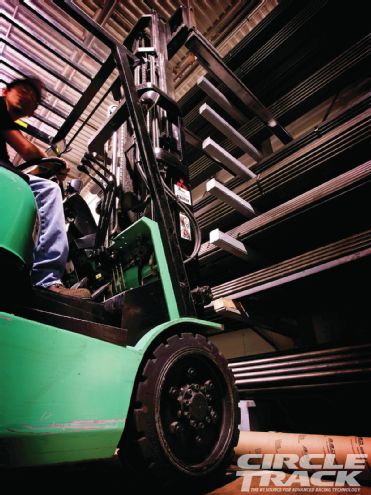 Materials that seem just alike to the layman may have very different properties. For example, AED’s Al Lowe says that he can often steer his customers to the best alloy aluminum sheet that has the best strength-to-cost ratio if the customer is clear about what the material will be used for.
Materials that seem just alike to the layman may have very different properties. For example, AED’s Al Lowe says that he can often steer his customers to the best alloy aluminum sheet that has the best strength-to-cost ratio if the customer is clear about what the material will be used for.
It's kind of like those children's toys in the kids meals a while back. Why all of a sudden do we have a toy with lead-based paint on it? They have been coming from China for years and they've been OK, but some bad product unexpectedly creeps through. It has to do with the lack of quality assurance systems in the manufacturers in China, so you have to be vigilant about what you are using that's manufactured there.
6. Do you test to make sure the product you are selling is up to quality standards?
This is important because of the reason just mentioned. We test a number of different ways. A lot of my business is based on the 4130 alloy. It goes into Sprint Cars and Midgets and some of the higher-end Modifieds and Late Models. We have established quality assurance programs that will monitor the incoming material based on paperwork documentation, dimensions, mill stencils, and things like that. We will also clip samples of that product and send it out to an independent lab for tensile, yield, and chemical evaluation to be sure that it meets the guidelines per the ASTM spec.
We will also send out samples to customers of ours that understand we are sending it to them for their evaluation. They can bend it. They can weld it. They can form it. Whatever they want to do to it, all we ask for is their honest feedback.
We also work with Wyatt Swaim, who consults with Lincoln Electric. Wyatt is one of the leading welding experts in the entire country, and we will submit blind samples of material from different mills and ask him to perform whatever evaluation he wants. He can cut it, weld it, weld it to two different materials. Whatever he wants to do, we just want his feedback. And he will give us back a blind report because we never tell him where the material comes from.
We also have developed a relationship with a company called CAPE Testing. "CAPE" stands for Center for Advanced Product Evaluation, and it is an automotive test center. We partnered with the company and did a crash test of a dirt Sprint Car in its crash test facilities. And that ultimately led to two tests where we evaluated the front structure of the Sprint Car and the top halo or rollcage structure. We are still digesting the information we learned, but in the process we not only evaluated the strength of the material we supplied, but also the integrity of the design of the chassis as well as how important the quality of the welds are.
7. Are there cheaper or better options for what I am purchasing?
I can give you an example why a question like this is important. We've got some aluminums: 3003 versus 5052. They are essentially both a very formable item, but the 5052 has a little more strength to it. It would make a better belly pan on a Sprint Car than a 3003. So, if we know what you are doing with it, and it goes back to maintaining good communication with your vendor, we can sometimes help the customer get a better product for his needs without costing him a lot of extra money. So if a customer is ordering a sheet of 3003 aluminum and tells us he's going to use it on his kid's Midget, we might suggest going with the 5052. You will be able to do everything you want to it. It's still cheap but it has more strength, so it should be safer.
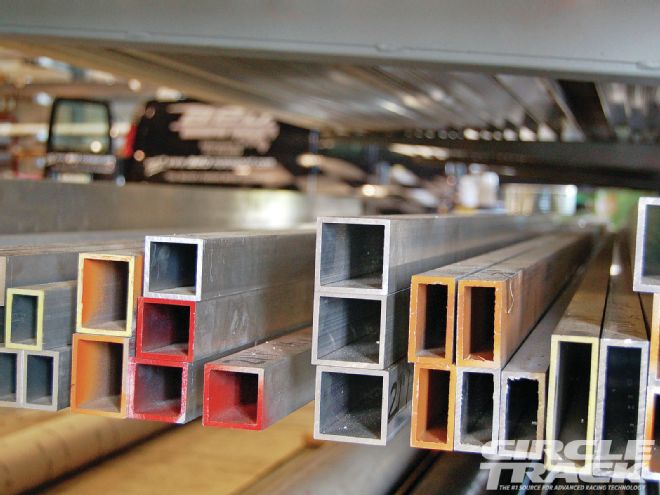 The quality of the metal you are building a steel rack or a work table out of isn’t as critical as the quality of the material that is going into your race car. If you communicate with your supplier when a specific order is going into a race car, will it take the time to make sure the material it supplies you is the very best of that stock?
The quality of the metal you are building a steel rack or a work table out of isn’t as critical as the quality of the material that is going into your race car. If you communicate with your supplier when a specific order is going into a race car, will it take the time to make sure the material it supplies you is the very best of that stock?
Also, one of the strengths of AED in particular is we sell a lot of 4130 alloy tubing. Because I move so much of it, a lot of times I can upgrade a customer from a DOM tube to 4130 grade tube if the rules permit it. To my knowledge, we are the only materials company whose focus is solely on motorsports, so we do have a pretty strong knowledge base here about how these materials are used and what works best in different situations.
8. Can you supply documentation for the materials you sell?
The reason for this question is simple. Are you getting what you are paying for? We know that there are some deficiencies in the processes that some of our vendors go through to get product to us. No one is perfect, and I'm not trying to say that AED will never have a hiccup. But I think it's important that whatever you are buying, you know what you are getting. We've had a pro-level racing team purchase aluminum plate, they lost the identity of it, and they used it to build a part that went on the race car. As it turned out, that material didn't have the strength compared to what they expected it to be. It is relevant with aluminum sheet if you are building panels or something that must perform as protection for the driver. You want to make sure you have the right grade of material. If you are making a bracket or a mounting point for the suspension, it's important you are sure you have the right grade of material. We can provide all the documentation upon request, but we also file it all in house for future reference if necessary.
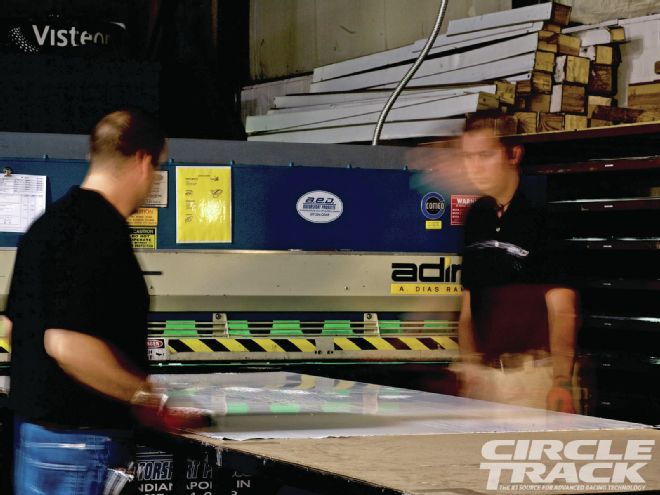 Working with a materials supplier that doesn’t require large minimum orders can be critical to a chassis manufacturer that doesn’t use a fraction of the steel a more industrialized company may go through. Finding a supplier that will cut and deliver exactly what you need—and no more—can help turn a failing business into a profitable one.
Working with a materials supplier that doesn’t require large minimum orders can be critical to a chassis manufacturer that doesn’t use a fraction of the steel a more industrialized company may go through. Finding a supplier that will cut and deliver exactly what you need—and no more—can help turn a failing business into a profitable one.
9. Are you familiar with racing?
We won't ever tell you how to build a race car, but I know that being around the racing industry like we are has given us insights that can be beneficial to our customers. A materials supplier that is concentrating on other industries simply won't have that level of knowledge to help make sure you get what you need.
An example: Structural tubing, which is the square and rectangular steel tubing. We supply a lot of that for simple things. Tool chests, racks, trailers, cabinets, and things like that. But we also have the customer who uses square tubing in his race cars. A lot of our Late Models and Modifieds have square tubing throughout. If we understand that you are building a race car with it or the front portion of a Modified out of this tubing, we will cherry pick our lot and give you the best of the best. And that goes back to us buying from the same mills, or rather the right mills. Our stuff on the whole is straighter, it is a more true product. So we'll make sure we send out only the best of the best when we know it is going into a race car, but you get what you get when you are building some shelves.
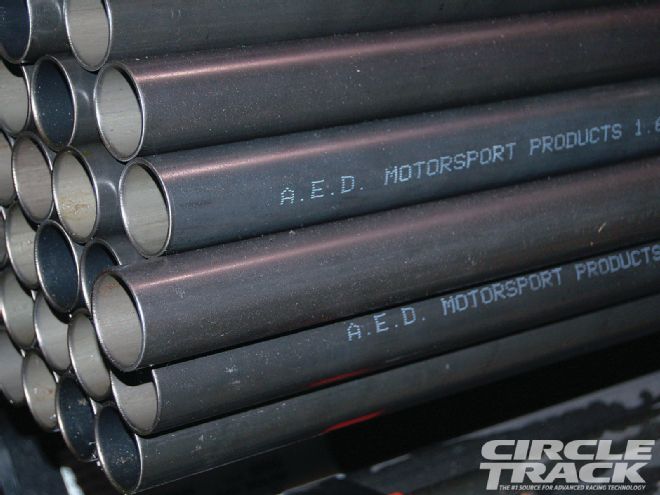 Proper documentation and marking of materials is important and can help you avoid picking up a piece of tubing with the wrong wall thickness and welding it into your car.
Proper documentation and marking of materials is important and can help you avoid picking up a piece of tubing with the wrong wall thickness and welding it into your car.
Also, we know that some rulebooks have a minimum wall thickness, and that minimum is measured at the radius of a bend. We know that if a customer asks for tubing with that minimum wall thickness, it's going to be too thin in places once he bends it. So we can remind him that he may need to increase that initial wall thickness.
So, there are lots and lots of little things that my staff and I have picked up over the years that really affect race car builders and teams. We aren't trying to write the rulebooks or tell people how to build their cars, but we catch things. And so we can help them avoid some pretty frustrating pitfalls.
10. Do you have programs for shipping materials? What are your costs?
We always like to have customers come into our shop so that we can talk to them face to face, but that's not always realistic. One of the things that we take pride in at AED is we are very good at making product go away. Far, far away if necessary.
We ship globally. We utilize practically every means of shipping available when it comes to shipping materials to our customers. And you practically have to if you are going to minimize the customer's costs for shipping. We ship UPS and FedEx-type packaging, we ship on flatbeds and common carrier, we ship on aircraft when product goes overseas--and that's actually more common than it sounds when it comes to metals. We try very hard to keep up with current shipping costs and what options are available to keep our customers' shipping costs down. There are some things going on within the motor carrier industry where the costs of these long products--the tubing and the bars--are going up. They are reclassifying how these products ship. So we are currently very carefully monitoring how these products are going to ship and what the upcharges are going to be. So by knowing how race car builders are going to be using this material allows me to help them out. For example, I know that 16 feet is the threshold dimension in the motor freight industry now. That's a brand new deal. But a lot of our products are manufactured at the mill in 20- or 24-foot lengths.
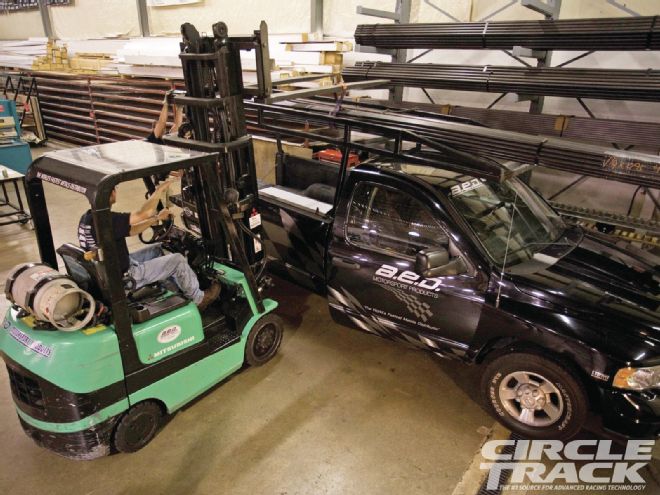 Local delivery is nice, but many of us aren’t close to our materials supplier. Shipping steel is expensive, but so is wasting a lot of tubing because it was cut to fit the container and not to your useage. Make sure to balance shipping costs with getting tubing in lengths that will allow you to minimize waste.
Local delivery is nice, but many of us aren’t close to our materials supplier. Shipping steel is expensive, but so is wasting a lot of tubing because it was cut to fit the container and not to your useage. Make sure to balance shipping costs with getting tubing in lengths that will allow you to minimize waste.
Can we do something to help our customer save a little bit on the freight? Probably. We can cut the tubing and package it down to 16 foot and cut some costs. But the question is, what is his net savings? If I know he uses 10 foot lengths and I take that 20-foot piece of tubing and cut him 16-foot lengths, how much have I wasted? Can he use all those six-foot sticks after he's cut the tubing or are they garbage? So we will ask him, "What do you start with?" And then we will work with him that way.
The economy of shipping steel tubing around the country really depends on who you are and how you value your time. We are located in Indianapolis, and we have guys that come in from the middle of Tennessee to pick up material, and we can ship it to them for $125. They might spend 10 hours on the road, but they look at their time differently. When it comes to shipping the raw materials for building a race car, you have to take a hard look at how much an hour of your time is worth versus the cost of having it shipped directly to your door. The answer is going to be different for everybody.
The answers to these 10 questions are critical to getting the best possible foundation for your new race car build or even a simple front clip repair. Your choice of a metals supplier can mean the difference between winning and just driving around in circles. So choose wisely.